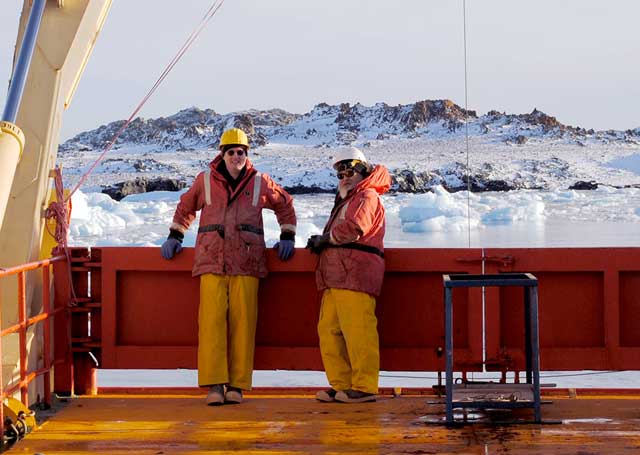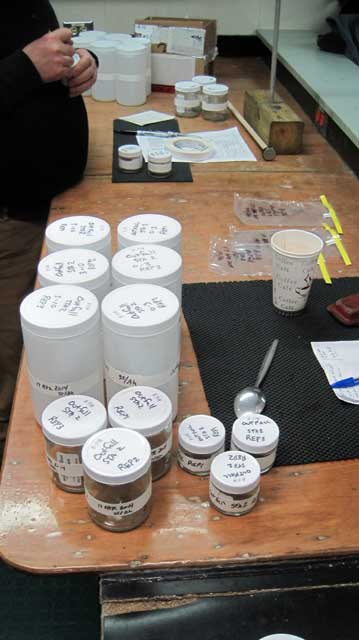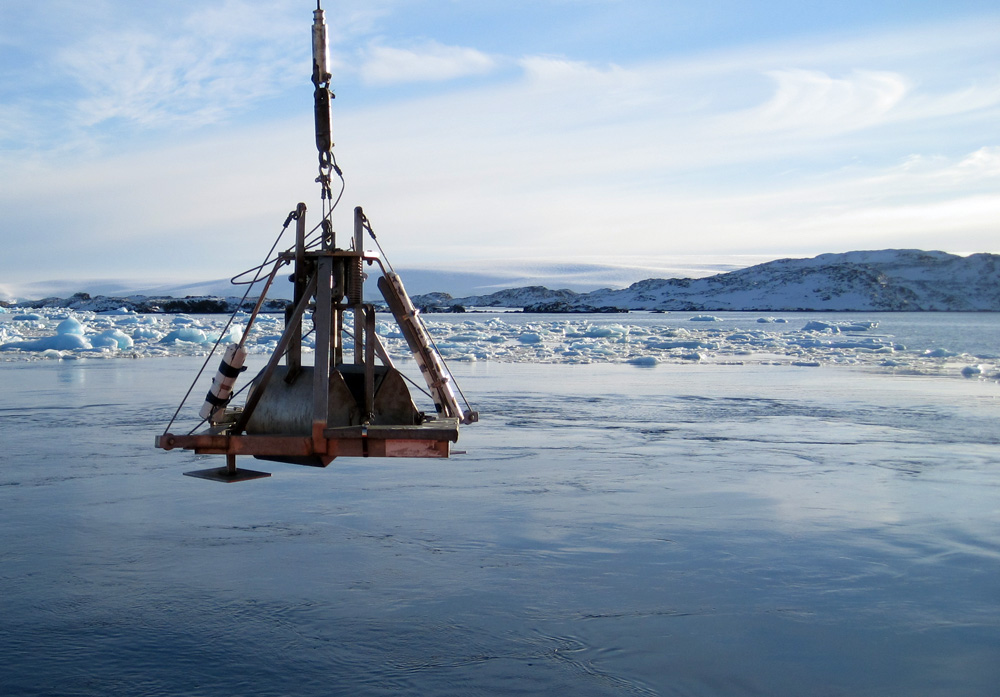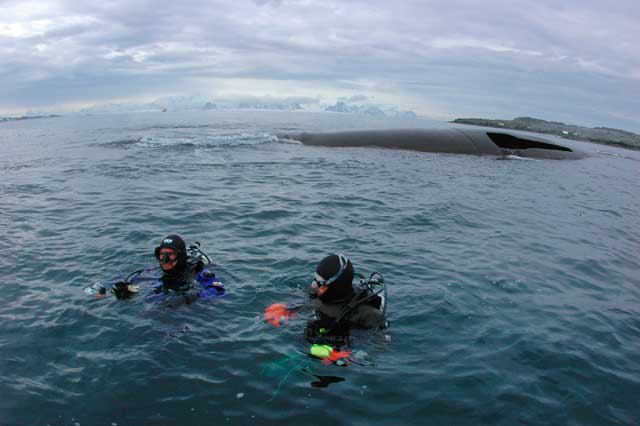Pristine protectionUSAP begins environmental monitoring program around Palmer StationPosted August 1, 2014
The U.S. Antarctic Program (USAP) “The intent was always to take what we learned in McMurdo and apply it at other places, because we want to look at human impacts where they occur,” said Andrew Klein 
Photo Courtesy: Andrew Klein
Texas A&M scientists Andrew Klein and Steve Sweet on the deck of the GOULD while collecting marine sediments for environmental monitoring.
Similar to the environmental monitoring program at McMurdo Station, which began with a three-year pilot project in 1999, scientists will collect terrestrial soil samples, marine sediments and even tissue samples from some of the critters that live within the seafloor near Palmer Station The researchers analyze the samples for a suite of contaminants, particularly hydrocarbons from crude oil, as well as trace metals and even legacy pollutants like polychlorinated biphenyl (PCB), once used in coolants and other products but have been banned internationally since 2001. Established during the austral summer of 1967-68, Palmer Station houses about 44 support personnel and scientists. The research vessel Laurence M. Gould Klein said he would expect to see lower levels of contamination at Palmer Station than at McMurdo Station, which is much larger. Environmental practices in the past were more lax until the establishment of the 1991 Protocol on Environmental Protection “The activity level is so much less at Palmer than McMurdo,” Klein noted. 
Photo Credit: Andrew Klein
Marine seafloor sediment samples from near Palmer Station are prepared for shipment back to the United States.
He and Steve Sweet, a senior research associate at with the Geochemical and Environmental Research Group This year marks the 25th anniversary of Antarctica’s worst environmental disaster when the oil tanker Bahía Paraíso ran aground about three kilometers from Palmer Station. Some 600,000 liters of diesel oil spilled into the sea. (The incident would be overshadowed less than two months later by the Exxon Valdez oil spill in Prince William Sound, Alaska, when at least 40 million liters of crude oil was released into the environment.) The National Science Foundation (NSF) Polly Penhale, environmental officer for the NSF’s Division of Polar Programs “Frankly, it was a challenge because I didn’t know anything about fuel spills and didn’t want to know anything about fuel spills – but it all worked out,” she said. “Now we’re establishing a new program that will provide a baseline to track potential environmental impacts from human disturbances moving forward. “The NSF, through its management of the USAP, has helped lead the way among the international community in environmental stewardship of the fragile Antarctic environment,” she added. Part of the Bahía Paraíso still sticks out of the water today. Klein and Sweet took advantage of being aboard the Gould to collect sediment samples from many of the same sites that were sampled a quarter-century ago aboard the research vessel Polar Duke. “The circle is closing a little bit, so to speak,” Klein said of the return of Texas A&M to Palmer Station and the Bahía Paraíso wreck. They deployed a Smith-McIntyre grab sampler, a device with two sides that when it hits the bottom snaps together to form a bucket, scooping up a sample of the seafloor. More than 20 samples were taken. “This successful sampling will enable us to examine how petroleum hydrocarbon levels have changed over the intervening years since the Bahía Paraíso spill,” he said, as well as how the structure of the benthic biological communities may have changed. Klein said the team would be able to compare their results from today against those in 1989 that were taken from the same locations. “Some of the differences we see could be due to different sampling approaches, the others due to real changes in the benthic community. It is, however, at least a chance for a comparison of sorts,” he said. 
Photo Courtesy: Andrew Klein
Texas A&M scientists who were involved in the response to the 1989 Bahía Paraíso accident.
Divers collected marine sediment samples at another 19 sites near Palmer Station and Old Palmer, a facility used for a couple of years in the mid-1960s. Those sites represented areas with possible ongoing environmental impacts, according to Klein. The dives were relatively shallow, all less than 30 meters in depth. “I was pretty happy with what we found,” Klein said, explaining that there was some expectation that it may be difficult to find suitable sediments to sample. The team will also establish areas on Anvers Island, where Palmer Station is located, for collecting terrestrial soil samples. The relatively small size of the area will allow the researchers to set up a dense sampling grid. “We’ll be able to sample quite extensively at Palmer,” Klein said. Human impacts on Antarctica have garnered big headlines in recent years. A study released last month suggested a surge in tourism, as well as increasing infrastructure for research facilities, is threatening the continent’s fragile ecosystem. Another study late last year reported finding a toxic flame retardant in the tissue of Adélie penguins. “Our research will determine if there are any long-lasting effects of the spill and monitor other human activities to ensure there are no additional impacts,” Klein said. |



For USAP Participants |
For The Public |
For Researchers and EducatorsContact UsU.S. National Science FoundationOffice of Polar Programs Geosciences Directorate 2415 Eisenhower Avenue, Suite W7100 Alexandria, VA 22314 Sign up for the NSF Office of Polar Programs newsletter and events. Feedback Form |



